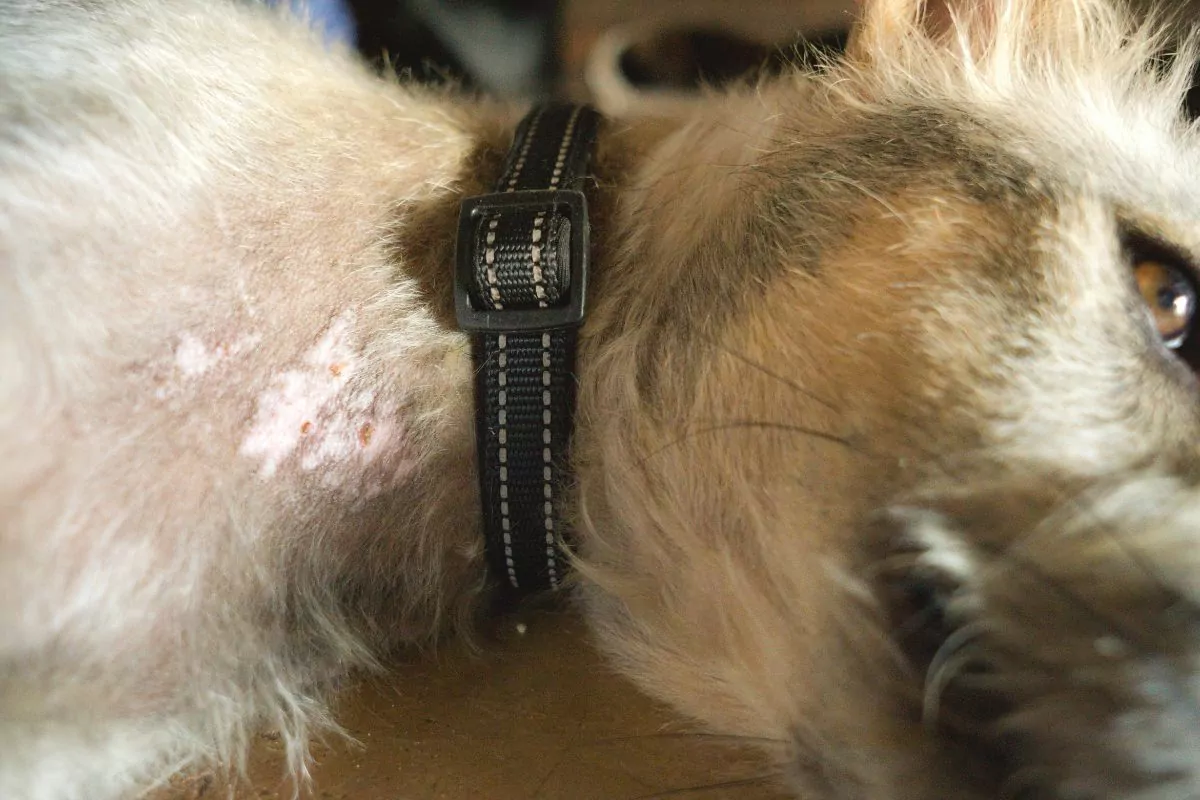What is Vitiligo in Dogs?
Vitiligo in dogs is a relatively unknown and rare condition. It was described in humans for the first time more than 1500 years ago but only more recently recognized in dogs.
Areas with less or no skin pigmentation are characteristic signs of Vitiligo in dogs, often sharply marked compared to surrounding fur and skin. All in all, a really fascinating condition to know more about!

The Causes of Canine Vitiligo
Vitiligo’s exact cause, also called the etiology, has yet to be fully understood or known. However, we know it occurs due to a lack of melanocytes in certain afflicted areas. The lack of melanocytes can occur due to their destruction or reduction of them.
A melanocyte is a type of specialized skin cell present in the bottom layer of the skin, an area called the hypodermis.
The primary function of melanocytes is to produce melanin. Melanin is the pigment responsible for skin and hair color. When there is a lack of melanocytes in a given area, it causes that area of skin and hair to become colorless, aka white.
Sometimes only the fur is affected, but skin Vitiligo in dogs is the most common form, where skin and hair turn white.
The condition can be hereditary, especially in cases where patients are born with antibodies toward melanin. Dogs can, however, also acquire Vitiligo due to other conditions.
Some conditions that may cause Vitiligo primarily affect the endocrine systems. These include Addison’s disease, diabetes, and thyroid dysfunction (over- or underactive thyroid).
In some cases, Vitiligo can also occur due to trauma to the skin, such as severe sunburn or a lesion. It can also occur as a response to severe stress. The most common form is, however, the hereditary form.
Are Some Dog Breeds Predisposed to Vitiligo?
Albeit the most common pigmentation condition in humans, animals with Vitiligo are rare. But maybe you’ve seen Vitiligo dog lips or a classic dog with white spots on the skin all over?
Several things can cause Vitiligo in dogs, but it is often hereditary. Being a hereditary disease also means that some breeds are at higher risk of developing Vitiligo. These are:
- Rottweilers.
- Dachshunds.
- Siberian Huskies.
- Labradors (yellow).
- Doberman.
- German Shorthaired Pointer.
If you are an owner of one of these breeds, it is worth looking out for signs of dog Vitiligo – especially if you know Vitiligo is present in the family!
Is Canine Depigmentation a Cause for Concern?
But with the condition being hereditary, is there something to worry about regarding Vitiligo in dogs? The short answer is no. If you know your dog’s family history and know that none of the nearest members of the family has dealt with it, it is improbable your dog will develop the condition.
However, you should, of course, keep an eye out for any sudden changes in your dog’s coloration. Most cases of Vitiligo happen when the dog is young, so if your older dog suddenly starts changing color or white spots appear, it might be well worth a trip to the veterinarian.
At times an owner may mistake Vitiligo as simply an older dog getting grey hair, so keep an eye on the skin underneath to ensure that you get all the vital signs of what could possibly be an underlying condition.
Types of Vitiligo in Dogs
Researchers and veterinarians generally split Vitiligo in dogs into two main categories; focal or generalized Vitiligo.
Focal Vitiligo is where the whitening of fur and skin only affects one area. This type will often appear as a “dog Vitiligo nose” that is entirely white.
Generalized Vitiligo is, however, where multiple white patches appear all over the body in random or symmetric patterns. Often this will occur as a dog with white spots on the belly or similar whitened areas.

The Symptoms
Dog Vitiligo is entirely painless in itself. If associated with an underlying condition, this one may cause your dog some level of discomfort that can require veterinary intervention.
Vitiligo often starts in young animals with a few white areas. As the animal ages, the melanocytes are destroyed and die off. The skin in affected areas will therefore turn pink or white. The hair and fur in these areas will also turn white.
Most often, in dogs, Vitiligo appears in the face as white spots on the dog’s lips or a loss of pigment around the eyes. As the disease progresses, other melanocytes die off, and the condition spreads from beyond the face, affecting typically footpads and the belly first.
Eventually, the condition can affect the whole body, seen as white patches all over. In most cases, the full extent of the spread will occur within six months of the first onset of Vitiligo.
In some cases, the whitening of the skin and fur can wax and wane, seemingly disappearing completely to reappear as white.
As Vitiligo occurs due to a lack of melanocytes, it rarely affects the skin in other ways, with little to no inflammation, lesions, or similar conditions in areas affected by Vitiligo.
How is Canine Vitiligo Diagnosed?
Any significant and sudden changes in your dog should warrant a visit to a veterinarian. Although Vitiligo is not painful, it may be a sign of something else, which will be essential to catch and treat.
When booking an appointment, it is vital to inform your veterinarian when you first noticed the Vitiligo, where it appeared, and if it comes and goes.
It is also essential to summarize any sudden changes that may have occurred in your dog’s life, as Vitiligo can also occur due to stress. Has a baby entered the home? Any recent moves? Maybe you haven’t had as much time to take the dog for walks?
Please don’t feel guilty about these things; it happens to all dog owners at some point! Just ensure you are upfront with your veterinarian about it.
As always, it is also vital to inform your veterinarian of any supplements and medication your dog may be receiving and mention any existing conditions that may affect your furry best friend.
After listening to your dog’s history, your veterinarian will thoroughly examine your pet, focusing especially on the skin. It is also likely that a blood sample will be necessary to rule out any possible underlying conditions. If a skin condition is suspected, a sample (biopsy) from the skin may also be a good idea.
In the biopsy, your veterinarian may be able to see the lack of melanocytes in the affected areas, although this can, at times, be complicated.
Treatment and Management Options
There is currently no available treatment for Vitiligo that will allow the skin to regain its lost pigment. But it is therefore also important to remember that although changing your dog’s appearance, it will not cause your dog to experience any pain or discomfort.
If no underlying condition is responsible, most dogs will be able to live comfortably for the rest of their life with the condition.
If the veterinary examination or blood test revealed an underlying reason for the Vitiligo, this would need addressing and, if possible, treatment.
If stress seems to be the underlying reason, the veterinarian may focus on making the environment less stressful or refer your dog for help from a behavioral therapist. With the use of training and some over-the-counter products, a dog can, in many cases, significantly reduce its stress levels!
If this happens due to an underlying condition, the Vitiligo may disappear once treatment is complete. It is not something a veterinarian will be able to guarantee.
Some anecdotal evidence suggests giving dogs Vitiligo supplements like omega-3 fatty acids and vitamin c, as well as keeping them more out in the sun. However, there needs to be more research on the efficacy of these treatments, and nutritional support is generally not known to be effective at best when treating Vitiligo.
The best thing you can do as an owner is to keep loving your dog as much as you did before its appearance started to change. Luckily, to most owners, Vitiligo is not a big deal and does not affect family life.
FAQs on Vitiligo in Dogs
Can all dogs get Vitiligo?
Although some breeds are more prone to the conditions, as it is hereditary, all dogs can get Vitiligo. Most commonly seen in young dogs, but all ages can be afflicted. Therefore you should make sure not to mistake greying hair for true Vitiligo!
Is Vitiligo painful?
No! Although it may be worrying to see your best friend change appearance practically overnight, it is not painful, itchy, or uncomfortable for your dog. Unlike us, dogs are unaware of how they look, and no evidence suggests that a dog cares about suddenly getting a white nose.
What dogs do care about, however, is our reaction. If you suddenly start reacting stressful or fuzzing over your dog, that may cause your dog to worry and even react. So if your dog is suddenly displaying spotty white lips, give the vet a call and your dog an extra treat.
Can white spots be a sign of skin cancer?
In humans, there are reports of some types of skin cancer treatments causing Vitiligo, but there does not seem to be an association between cancer and Vitiligo. Therefore, owners should not worry excessively about cancer once white spots appear.
Can the fur be dyed?
Dying the fur may not necessarily benefit your dog. However, if you, as the owner, are very upset about the changes in your dog’s appearance, it may be a viable option to color some patches. Just ensure only to use dye made for use in animals.
Some suggest tattooing the skin as a viable option to remove the signs of Vitiligo. However, as the condition is neither painful nor dangerous, submitting a dog to a large tattoo seems unnecessary.
Can cats get Vitiligo?
Although it is even rarer in cats than dogs, cats can suffer from Vitiligo for many of the same reasons as dogs.
Can you prevent Vitiligo?
Owners should not breed dogs known to have Vitiligo as to decrease the likelihood of passing the condition on to offspring. However, as the cause is not fully understood, there is no way of preventing Vitiligo in animals known to carry the gene for it.

Summary
If you see a dog with white spots or a very white nose, it might be affected by Vitiligo. Although rare, it is seen occasionally, often giving the animals a unique and adorable appearance!
If your dog suddenly starts changing color, you should get it checked out by a veterinarian to ensure that nothing untoward is going on. Hopefully, it’s nothing serious, and your now spotty friend will more than likely be able to live out its days happy and healthy!
